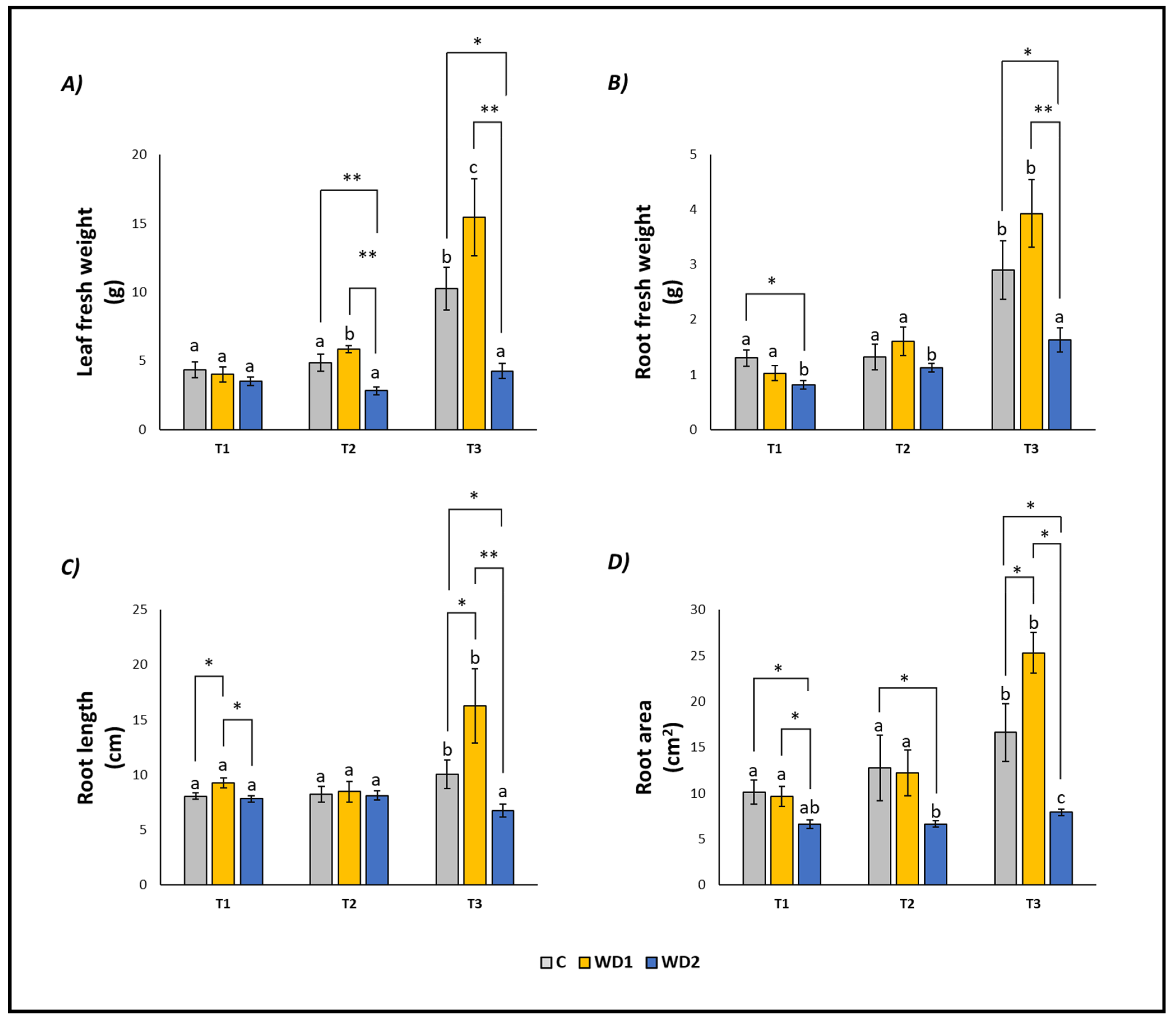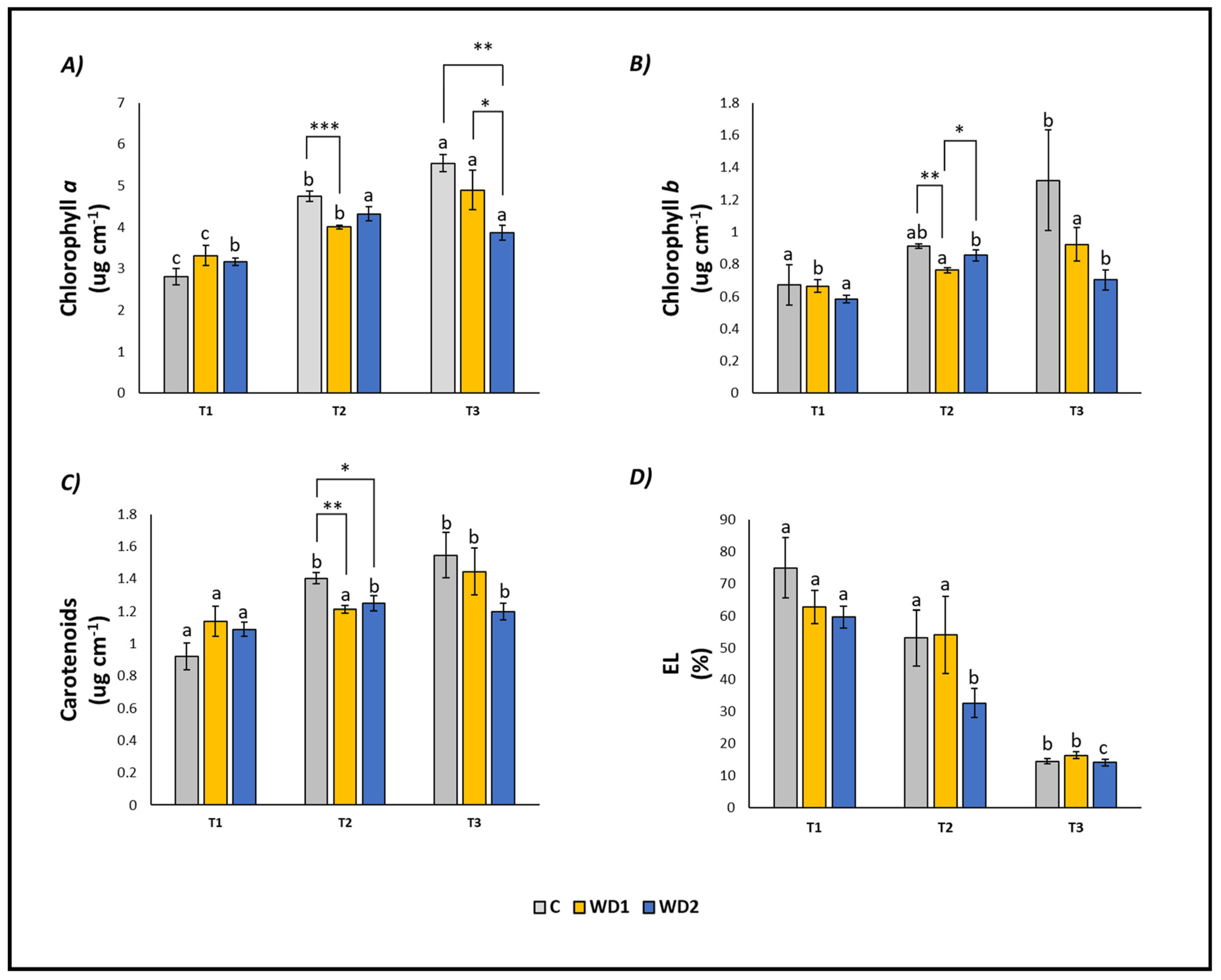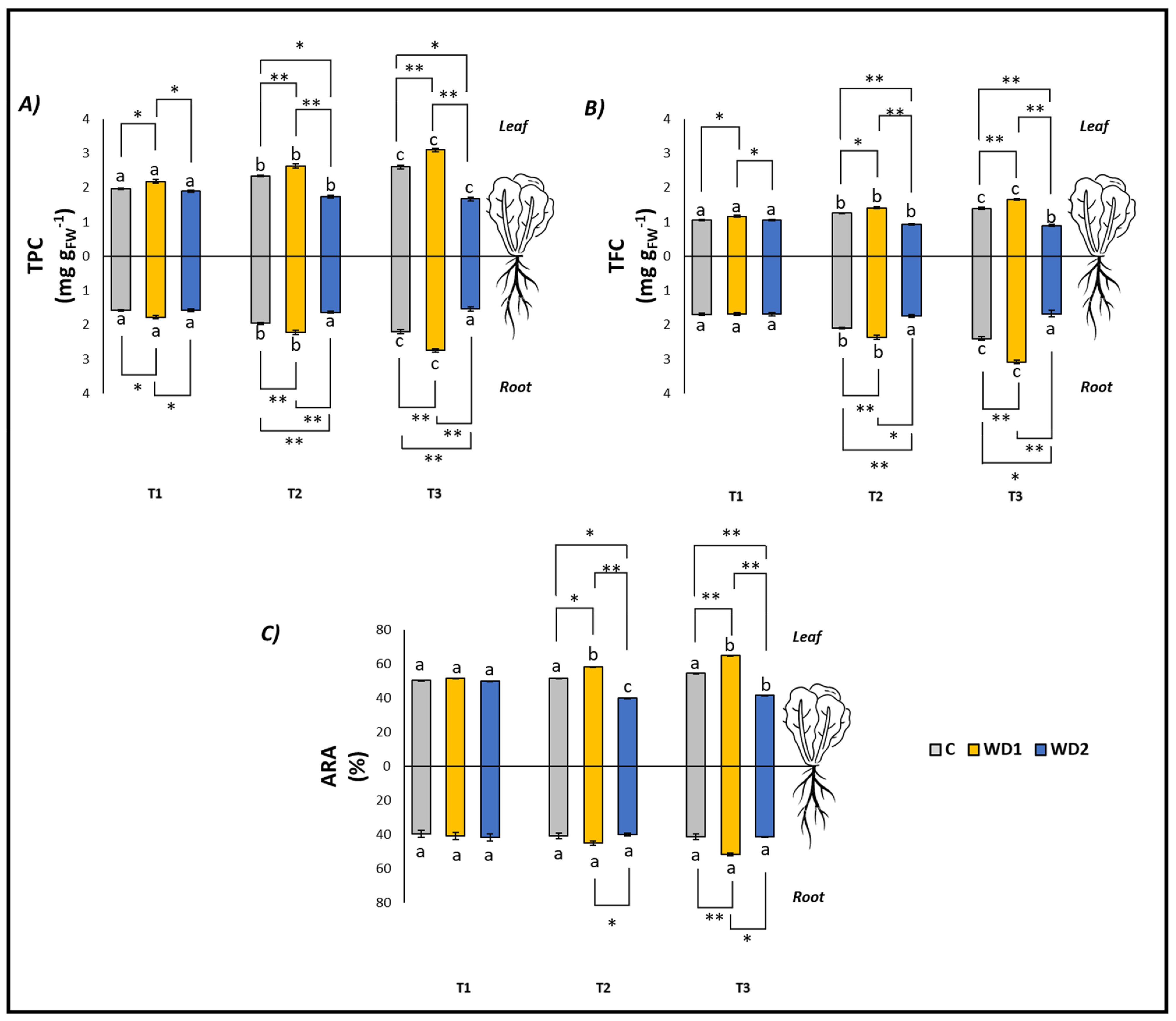Hormetic Effect of Wood Distillate on Hydroponically Grown Lettuce
Abstract
:1. Introduction
2. Results
2.1. Temporal Trends
2.2. Effects of WD
3. Discussion
4. Materials and Methods
4.1. Experimental Protocol and Growing Conditions
Wood Distillate Characteristics
4.2. Plant Analysis
4.2.1. Biometric Parameters
4.2.2. Pigment Content
4.2.3. Electrolyte Leakage
4.2.4. Antioxidant Compounds
4.3. Statistical Analysis
5. Conclusions
Author Contributions
Funding
Data Availability Statement
Acknowledgments
Conflicts of Interest
References
- Sheikh, B.A. Hydroponics: Key to sustain agriculture in water stressed and urban environment. Pak. J. Agric. Agric. Eng. Vet. Sci. 2006, 22, 53–57. [Google Scholar]
- Hemathilake, D.M.K.S.; Gunathilake, D.M.C.C. High-productive agricultural technologies to fulfill future food demands: Hydroponics, aquaponics, and precision/smart agriculture. In Future Foods; Academic Press: Cambridge, MA, USA, 2022; pp. 555–567. [Google Scholar]
- Gashgari, R.; Alharbi, K.; Mughrbil, K.; Jan, A.; Glolam, A. Comparison between growing plants in hydroponic system and soil based system. In Proceedings of the 4th World Congress on Mechanical, Chemical, and Material Engineering, Madrid, Spain, 16–18 August 2018; Volume 18, pp. 1–7. [Google Scholar]
- Tocquin, P.; Corbesier, L.; Havelange, A.; Pieltain, A.; Kurtem, E.; Bernier, G.; Périlleux, C. A novel high efficiency, low maintenance, hydroponic system for synchronous growth and flowering of Arabidopsis thaliana. BMC Plant Biol. 2003, 3, 2. [Google Scholar] [CrossRef] [PubMed]
- Sharma, N.; Acharya, S.; Kumar, K.; Singh, N.; Chaurasia, O.P. Hydroponics as an advanced technique for vegetable production: An overview. J. Soil Water Conserv. 2018, 17, 364–371. [Google Scholar] [CrossRef]
- Benke, K.; Tomkins, B. Future food-production systems: Vertical farming and controlled-environment agriculture. Sustain. Sci. Prac. Pol. 2017, 13, 13–26. [Google Scholar] [CrossRef]
- Romeo, D.; Vea, E.B.; Thomsen, M. Environmental Impacts of Urban Hydroponics in Europe: A Case Study in Lyon. Proc. CIRP 2018, 69, 540–545. [Google Scholar] [CrossRef]
- Despommier, D. The Rise of Vertical Farms. Sci. Am. 2009, 301, 80–87. [Google Scholar] [CrossRef] [PubMed]
- European Commision. 2018. Available online: https://joint-research-centre.ec.europa.eu/publications/agricultural-land-abandonment-eu-within-2015-2030_en#:~:text=The%20incremental%20abandonment%20within%202015-2030%20is%20nevertheless%20projected,the%20equivalent%20of%203%25%20of%20total%20agricultural%20land (accessed on 8 November 2023).
- FAO. 2012. Available online: https://www.fao.org/fileadmin/user_upload/esag/docs/AT2050_revision_summary.pdf (accessed on 8 November 2023).
- Raviv, M.; Krasnovsky, A.; Medina, S.; Reuveni, R. Assessment of various control strategies for recirculation of greenhouse effluents under semi-arid conditions. J. Hortic. Sci. Biotechnol. 1998, 73, 485–491. [Google Scholar] [CrossRef]
- Dutta, M.; Gupta, D.; Sahu, S.; Limkar, S.; Singh, P.; Mishra, A.; Mutlu, R. Evaluation of Growth Responses of Lettuce and Energy Efficiency of the Substrate and Smart Hydroponics Cropping System. Sensors 2023, 23, 1875. [Google Scholar] [CrossRef]
- Knox, J.; Hess, T.; Daccache, A.; Wheeler, T. Climate change impacts on crop productivity in Africa and South Asia. Environ. Res. Lett. 2012, 7, 034032. [Google Scholar] [CrossRef]
- Vernieri, P.; Borghesi, E.; Ferrante, A.; Magnani, G. Application of biostimulants in floating system for improving rocket quality. Int. J. Environ. Sci. Technol. 2005, 3, 86–88. [Google Scholar]
- Marchica, A.; Ascrizzi, R.; Flamini, G.; Cotrozzi, L.; Tonelli, M.; Lorenzini, G.; Pellegrini, E. Ozone as eustress for enhancing secondarymetabolites and bioactive properties in Salvia officinalis. Ind. Prod. 2021, 170, 113730. [Google Scholar] [CrossRef]
- Brezeanu, C.; Brezeanu, P.M.; Stoleru, V.; Irimia, L.M.; Lipșa, F.D.; Teliban, G.C.; Murariu, O.C. Nutritional value of new sweet pepper genotypes grown in organic system. Agriculture 2022, 12, 1863. [Google Scholar] [CrossRef]
- Grewal, A.; Abbey, L.; Gunupuru, L.R. Production, prospects and potential application of pyroligneous acid in agriculture. J. Anal. Appl. Pyrolysis 2018, 135, 152–159. [Google Scholar] [CrossRef]
- Vannini, A.; Fedeli, R.; Guarnieri, M.; Loppi, S. Foliar Application of Wood Distillate Alleviates Ozone-Induced Damage in Lettuce (Lactuca Sativa L.). Toxics 2022, 10, 17. [Google Scholar] [CrossRef]
- Chen, J.; Wu, J.H.; Si, H.P.; Lin, K.Y. Effects of adding wood vinegar to nutrient solution on the growth, photosynthesis, and absorption of mineral elements of hydroponic lettuce. J. Plant Nutr. 2016, 39, 456–462. [Google Scholar] [CrossRef]
- Singh, H.; Dunn, B.; Payton, M. Hydroponic pH modifiers affect plant growth and nutrient content in leafy greens. J. Hortic. Res. 2019, 27, 31–36. [Google Scholar] [CrossRef]
- Pan, X.; Zhang, Y.; Wang, X.; Liu, G. Effect of adding biochar with wood vinegar on the growth of cucumber. In IOP Conference Series: Earth and Environmental Science, Proceedings of the 3rd International Conference on Energy Materials and Environment Engineering, Bangkok, Thailand, 10–12 March 2017; IOP Publishing: Bristol, UK, 2017; Volume 61, p. 012149. [Google Scholar]
- Wei, Q.; Ma, X.; Dong, J. Preparation, chemical constituents and antimicrobial activity of pyroligneous acids from walnut tree branches. J. Anal. Appl. Pyrolysis 2010, 87, 24–28. [Google Scholar] [CrossRef]
- Fedeli, R.; Vannini, A.; Celletti, S.; Maresca, V.; Munzi, S.; Cruz, C.; Loppi, S. Foliar application of wood distillate boosts plant yield and nutritional parameters of chickpea. Ann. Appl. Biol. 2023, 182, 57–64. [Google Scholar] [CrossRef]
- Fedeli, R.; Vannini, A.; Guarnieri, M.; Monaci, F.; Loppi, S. Bio-based solutions for agriculture: Foliar application of wood distillate alone and in combination with other plant-derived corroborants results in different effects on lettuce (Lactuca sativa L.). Biology 2022, 11, 404. [Google Scholar] [CrossRef]
- Fedeli, R.; Vannini, A.; Grattacaso, M.; Loppi, S. Wood distillate (pyroligneous acid) boosts nutritional traits of potato tubers. Ann. Appl. Biol. 2023, 183, 135–140. [Google Scholar] [CrossRef]
- Dissatian, A.; Sanitchon, J.; Pongdontri, P.; Jongrungklang, N.; Jothityangkoon, D. Potential of wood vinegar for enhancing seed germination of three upland rice varieties by suppressing malondialdehyde production. AGRIVITA J. Agric. Sci. 2018, 40, 371–380. [Google Scholar]
- Mungkunkamchao, T.; Kesmala, T.; Pimratch, S.; Toomsan, B.; Jothityangkoon, D. Wood vinegar and fermented bioextracts: Natural products to enhance growth and yield of tomato (Solanum lycopersicum L.). Sci. Hortic. 2013, 154, 66–72. [Google Scholar] [CrossRef]
- Wang, Y.; Qiu, L.; Song, Q.; Wang, S.; Wang, Y.; Ge, Y. Root proteomics reveals the effects of wood vinegar on wheat growth and subsequent tolerance to drought stress. Int. J. Mol. Sci. 2019, 20, 943. [Google Scholar] [CrossRef]
- Fedeli, R.; Fiaschi, T.; Angiolini, C.; Maccherini, S.; Loppi, S.; Fanfarillo, E. Dose-Dependent and Species-Specific Effects of Wood Distillate Addition on the Germination Performance of Threatened Arable Plants. Plants 2023, 12, 3028. [Google Scholar] [CrossRef] [PubMed]
- Maresca, V.; Fedeli, R.; Vannini, A.; Munzi, S.; Corrêa, A.; Cruz, C.; Loppi, S. Wood distillate enhances seed germination of chickpea, lettuce, and basil. Appl. Sci. 2024, 14, 631. [Google Scholar] [CrossRef]
- de Lima, G.G.; Mendes, C.; de Marchi, G.; Vicari, T.; Cestari, M.M.; Gomes, M.F.; Leme, D.M. The evaluation of the potential ecotoxicity of pyroligneous acid obtained from fast pyrolysis. Ecotoxicol. Environ. Saf. 2019, 180, 616–623. [Google Scholar] [CrossRef]
- Fedeli, R.; Marotta, L.; Frattaruolo, L.; Panti, A.; Carullo, G.; Fusi, F.; Saponara, S.; Gemma, S.; Butini, S.; Cappello, A.R.; et al. Nutritionally-enriched tomatoes (Solanum lycopersicum L.) grown with wood distillate: Chemical and biological characterization for quality assessment. J. Food Sci. 2023, 88, 5324–5338. [Google Scholar] [CrossRef] [PubMed]
- Ofoe, R.; Qin, D.; Gunupuru, L.R.; Thomas, R.H.; Abbey, L. Effect of pyroligneous acid on the productivity and nutritional quality of greenhouse tomato. Plants 2022, 11, 1650. [Google Scholar] [CrossRef]
- Admane, N.; Cavallo, G.; Hadjila, C.; Cavalluzzi, M.M.; Rotondo, N.P.; Salerno, A.; Sanzani, S.M. Biostimulant Formulations and Moringa oleifera Extracts to Improve Yield, Quality, and Storability of Hydroponic Lettuce. Molecules 2023, 28, 373. [Google Scholar] [CrossRef]
- Trevisan, S.; Manoli, A.; Quaggiotti, S. A novel biostimulant, belonging to protein hydrolysates, mitigates abiotic stress effects on maize seedlings grown in hydroponics. Agronomy 2019, 9, 28. [Google Scholar] [CrossRef]
- Kalozoumis, P.; Vourdas, C.; Ntatsi, G.; Savvas, D. Can Biostimulants Increase Resilience of Hydroponically-Grown Tomato to Combined Water and Nutrient Stress? Horticulturae 2021, 7, 297. [Google Scholar] [CrossRef]
- Lobanov, V.; Keesman, K.J.; Joyce, A. Plants dictate root microbial composition in hydroponics and aquaponics. Front. Microbiol. 2021, 13, 848057. [Google Scholar] [CrossRef] [PubMed]
- Baenas, N.; García-Viguera, C.; Moreno, D.A. Elicitation: A tool for enriching the bioactive composition of foods. Molecules 2014, 19, 13541–13563. [Google Scholar] [CrossRef] [PubMed]
- Hasanuzzaman, M.; Bhuyan, M.; Anee, T.I.; Parvin, K.; Nahar, K.; Mahmud, J.A.; Fujita, M. Regulation of ascorbate-glutathione pathway in mitigating oxidative damage in plants under abiotic stress. Antioxidants 2019, 8, 384. [Google Scholar] [CrossRef]
- Manda, G.; Nechifor, M.T.; Neagu, T.M. Reactive oxygen species, cancer and anti-cancer therapies. Curr. Chem. Biol. 2009, 3, 22–46. [Google Scholar] [CrossRef]
- Barreca, D. Mechanisms of plant antioxidants action. Plants 2020, 10, 35. [Google Scholar] [CrossRef] [PubMed]
- Gulcin, İ. Antioxidants and antioxidant methods: An updated overview. Arch. Toxicol. 2020, 94, 651–715. [Google Scholar] [CrossRef]
- Galindo, F.S.; Pagliari, P.H.; Fernandes, G.C.; Rodrigues, W.L.; Boleta, E.H.M.; Jalal, A.; Céu, E.G.O.; Lima, B.H.D.; Lavres, J.; Teixeira Filho, M.C.M. Improving Sustainable Field-Grown Wheat Production with Azospirillum brasilense Under Tropical Conditions: A Potential Tool for Improving Nitrogen Management. Front. Environ. Sci. 2022, 10, 821628. [Google Scholar] [CrossRef]
- Aryal, S.; Baniya, M.K.; Danekhu, K.; Kunwar, P.; Gurung, R.; Koirala, N. Total phenolic content, flavonoid content and antioxidant potential of wild vegetables from Western Nepal. Plants 2019, 8, 96. [Google Scholar] [CrossRef]
- Chedea, V.S.; Pop, R.M. Total polyphenols content and antioxidant DPPH assays on biological samples. In Polyphenols in Plants; Academic Press: Cambridge, MA, USA, 2019; pp. 169–183. [Google Scholar]
- Han, X.; Shen, T.; Lou, H. Dietary polyphenols and their biological significance. Int. J. Mol. Sci. 2007, 8, 950–988. [Google Scholar] [CrossRef]
- Benzon, H.R.L.; Lee, S.C. Potential of wood vinegar in enhancing fruit yield and antioxidant capacity in tomato. Korean J. Plant Resour. 2016, 29, 704–711. [Google Scholar] [CrossRef]
- Kårlund, A.; Salminen, J.P.; Koskinen, P.; Ahern, J.R.; Karonen, M.; Tiilikkala, K.; Karjalainen, R.O. Polyphenols in strawberry (Fragaria× ananassa) leaves induced by plant activators. J. Agric. Food Chem. 2014, 62, 4592–4600. [Google Scholar] [CrossRef]
- Cruz, C.; Bio, A.F.M.; Domínguez-Valdivia, M.D.; Aparicio-Tejo, P.M.; Lamsfus, C.; Martins-Louçao, M.A. How does glutamine synthetase activity determine plant tolerance to ammonium? Planta 2006, 223, 1068–1080. [Google Scholar] [CrossRef] [PubMed]
- Celletti, S.; Fedeli, R.; Ghorbani, M.; Aseka, J.M.; Loppi, S. Exploring sustainable alternatives: Wood distillate alleviates the impact of bioplastic in basil plants. Sci. Total Environ. 2023, 900, 166484. [Google Scholar] [CrossRef] [PubMed]
- BioDea. Available online: https://biodea.bio/bio-wood-distillate/?lang=en (accessed on 1 December 2023).
- Lichtenthaler, H.K.; Buschmann, C. Chlorophylls and carotenoids: Measurement and characterization by UV-VIS spectroscopy. Curr. Protoc. Food Anal. Chem. 2001, 1, F4.3.1–F4.3.8. [Google Scholar] [CrossRef]
- Sunkar, R. Plant stress tolerance. Methods Mol. Biol. 2010, 639, 401. [Google Scholar]
- Fedeli, R.; Celletti, S.; Loppi, S.; Vannini, A. Comparison of the Effect of Solid and Liquid Digestate on the Growth of Lettuce (Lactuca sativa L.) Plants. Agronomy 2023, 13, 782. [Google Scholar] [CrossRef]
- Lamaro, G.P.; Tsehaye, Y.; Girma, A.; Vannini, A.; Fedeli, R.; Loppi, S. Evaluation of Yield and Nutraceutical Traits of Orange-Fleshed Sweet Potato Storage Roots in Two Agro-Climatic Zones of Northern Ethiopia. Plants 2023, 12, 1319. [Google Scholar] [CrossRef]
- Heimler, D.; Vignolini, P.; Dini, M.G.; Romani, A. Rapid tests to assess the antioxidant activity of Phaseolus vulgaris L. dry beans. J. Agric. Food Chem. 2005, 53, 3053–3056. [Google Scholar] [CrossRef]
- Anderson, M. PERMANOVA+ for PRIMER: Guide to Software and Statistical Methods; Primer-E Limited.: Auckland, New Zealand, 2008. [Google Scholar]
- Clarke, K.R.; Gorley, R.N. PRIMER v6: USersManual/Tutorial PRIMER-E; Plymouth Marine Laboratory: Plymouth, UK, 2006. [Google Scholar]



| Source of variation | Leaf fresh weight | Root fresh weight | Root length | Root area | |||||
| df | MS | F | MS | F | MS | F | MS | F | |
| Time | 2 | 166.95 | 35.09 *** | 13.51 | 37.91 *** | 36.32 | 5.71 *** | 252.54 | 16.43 *** |
| Treatment | 2 | 91.32 | 19.19 *** | 3.86 | 10.82 *** | 55.71 | 8.76 *** | 297.37 | 19.35 *** |
| Time × Treatment | 4 | 38.98 | 8.193 *** | 1.69 | 4.753 *** | 32.26 | 5.08 *** | 78.04 | 5.07 *** |
| Residual | 36 | 4.75 | 0.35 | 6.36 | 15.37 | ||||
| Total | 44 | ||||||||
| Source of variation | EL | Chlorophyll a | Chlorophyll b | Carotenoids | |||||
| df | MS | F | MS | F | MS | F | MS | F | |
| Time | 2 | 9857 | 50.49 *** | 34.91 | 77.31 *** | 1.35 | 8.63 *** | 1.50 | 19.99 *** |
| Treatment | 2 | 584.42 | 2.99 | 2.54 | 5.63 *** | 0.63 | 4.05 *** | 0.07 | 1.05 |
| Time × Treatment | 4 | 237.16 | 1.21 | 3.74 | 8.29 *** | 0.32 | 2.04 | 0.25 | 3.38 * |
| Residual | 36 | 195.24 | 0.451 | 0.16 | 0.07 | ||||
| Total | 44 | ||||||||
| Source of variation | Leaf TPC | Root TPC | Leaf TFC | Root TPC | |||||
| df | MS | F | MS | F | MS | F | MS | F | |
| Time | 2 | 0.73 | 74.01 *** | 0.99 | 84.53 *** | 0.18 | 63.21 *** | 1.83 | 134.4 *** |
| Treatment | 2 | 2.85 | 288.78 *** | 1.65 | 139.87 *** | 0.77 | 258.71 *** | 1.72 | 126.64 *** |
| Time × Treatment | 4 | 0.45 | 45.75 *** | 0.33 | 28.53 *** | 0.15 | 49.09 *** | 0.63 | 46.29 *** |
| Residual | 36 | 0.009 | 0.02 | 0.003 | 0.02 | ||||
| Total | 44 | ||||||||
| Source of variation | Leaf ARA | Root ARA | |||||||
| df | MS | F | MS | F | |||||
| Time | 2 | 55.33 | 5.69 ** | 59.91 | 5.12 * | ||||
| Treatment | 2 | 788.3 | 81.16 *** | 127.7 | 10.91 *** | ||||
| Time × Treatment | 4 | 169.6 | 17.45 *** | 46.46 | 3.97 ** | ||||
| Residual | 36 | 9.72 | 11.71 | ||||||
| Total | 44 | ||||||||
| (w/v)% | |
|---|---|
| KNO3 | 1.5 |
| Ca(NO3)2 4H2O | 1 |
| NH4H2PO4 | 0.5 |
| MgSO4 7H2O | 0.25 |
| KCl | 0.5 |
| H3BO3 | 0.25 |
| MnSO4 H2O | 1 |
| ZnSO4 7H2O | 1 |
| CuSO4 5H2O | 0.5 |
| (NH4)6Mo7O2 4H2O | 0.5 |
| FeNaEDTA | 2 |
Disclaimer/Publisher’s Note: The statements, opinions and data contained in all publications are solely those of the individual author(s) and contributor(s) and not of MDPI and/or the editor(s). MDPI and/or the editor(s) disclaim responsibility for any injury to people or property resulting from any ideas, methods, instructions or products referred to in the content. |
© 2024 by the authors. Licensee MDPI, Basel, Switzerland. This article is an open access article distributed under the terms and conditions of the Creative Commons Attribution (CC BY) license (https://creativecommons.org/licenses/by/4.0/).
Share and Cite
Fedeli, R.; Cruz, C.; Loppi, S.; Munzi, S. Hormetic Effect of Wood Distillate on Hydroponically Grown Lettuce. Plants 2024, 13, 447. https://doi.org/10.3390/plants13030447
Fedeli R, Cruz C, Loppi S, Munzi S. Hormetic Effect of Wood Distillate on Hydroponically Grown Lettuce. Plants. 2024; 13(3):447. https://doi.org/10.3390/plants13030447
Chicago/Turabian StyleFedeli, Riccardo, Cristina Cruz, Stefano Loppi, and Silvana Munzi. 2024. "Hormetic Effect of Wood Distillate on Hydroponically Grown Lettuce" Plants 13, no. 3: 447. https://doi.org/10.3390/plants13030447
APA StyleFedeli, R., Cruz, C., Loppi, S., & Munzi, S. (2024). Hormetic Effect of Wood Distillate on Hydroponically Grown Lettuce. Plants, 13(3), 447. https://doi.org/10.3390/plants13030447










